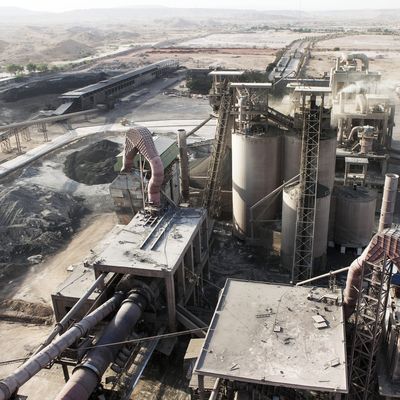
The blue planet is becoming grayer by the day, as Earth is paved over with concrete. The world churns out about 4 billion tons of cement, the glue that holds concrete together, every year, and the appetite for concrete is expected to balloon as humanity continues to move from rural areas into cities. Bill Gates cites an estimate that “the world will add 2 trillion square feet of buildings by 2060—the equivalent of putting up another New York City every month for the next 40 years.”
All of that building comes at a steep cost for the environment. Producing concrete requires heating limestone with other aggregates in a kiln at 1,450 degrees Celsius, fired by burning coal or other fossil fuels that produce carbon dioxide. (The amount of energy used to bake one ton of cement could power the average U.S. home for more than a month.) What’s more, the heated limestone vents CO2 into the atmosphere. If the concrete industry were a country, it would be the third-largest CO2 emitter, according to one estimate, responsible for 8 percent of annual global emissions, behind only China and the United States. On the current trajectory, global cement production is set to increase to over 5 billion tonnes a year over the next 30 years, according to the International Energy Agency, spewing more CO2 into the air with it.
The current Intergovernmental Panel on Climate Change models on how to avoid the worst-case scenarios of global warming rely on the deployment of significant amounts of carbon capture and sequestration in the latter part of the century, which is where new concrete technologies that trap and reuse C02 emissions may be key.
Two start-ups are making strides toward that goal. In mid-April, CarbonCure Technologies and CarbonBuilt won $7.5 million each in the Carbon XPRIZE competition, a global contest to develop ways to convert CO2 emissions into usable products like concrete. CarbonBuilt’s technology, developed by researchers at UCLA, is said to reduce the carbon footprint of concrete by more than 50 percent, by taking CO2 emissions directly from coal-fired power plants and other industrial facilities and infusing them into a new kind of concrete.
“All those emissions that you may have put out, you essentially lock them back up in the production of limestone,” said Gaurav Sant, one of the UCLA researchers who devised the technology. Sant and his team started with a compound called “portlandite,” derived from the name of traditional Portland cement, which uses hydrated lime to absorb CO2 during the curing and hardening phase. Using hydrated lime in a concrete mix reduces the amount of Portland cement by 60 to 90 percent. “If you were to replace that entire [concrete] business, you have the potential to utilize between a billion and 2 billion tons of carbon dioxide per year,” Sant said. “When you think about the fact this is utilization, not just mitigation, this is really a big number.” So far, CarbonBuilt has produced about 200 metric tons of product, Sant said.
CarbonCure is also working on technology to capture concrete’s C02 emissions, by retrofitting concrete plans to capture emissions and inject them back into wet concrete as it is being mixed. The C02 reacts with calcium ions in the concrete to form calcium carbonate, which helps bind together other ingredients and strengthen the concrete. So far, CarbonCure’s tech is installed in about 350 plants worldwide. Amazon and Microsoft have both invested in the company, and its goal is to sequester 500 million metric tons of carbon dioxide annually by 2030 — equivalent to taking 100 million cars off the road each year.
While these companies work on how to capture C02 emissions from concrete production, others are trying to curb emissions in the first place by cutting the cement mixture with less-carbon-intensive materials.
Simple clay is one such material. Karen Scrivener, a professor at the Ecole Polytechnique Fédérale in Lausanne, Switzerland, developed a way to replace a large portion of conventional cement with limestone calcined clay cement for use in concrete. “We came up with this idea 13 years ago now, and we’ve been really working to get it adopted in the industry,” Scrivener said. Called LC3, it could reduce the industry’s carbon footprint because clay contains very little carbon to begin with, so there’s almost no CO2 released when it’s heated, and it can be baked at 800 degrees Celsius, half the temperature of conventional cement. Taken together, these two benefits are estimated to reduce carbon emissions by 40 percent. LC3 is being produced at two large-scale plants, for use in construction in Colombia and the Ivory Coast, according to Scrivener, with trials under way in Europe this year, aiming for production in 2022.
“To me, that is a solution that can be practiced all over the world,” said Kimberly Kurtis, a professor of civil engineering at Georgia Tech. “If we adopt even a fraction of cement to be this limestone calcined clay, it will have an immediate positive effect. They’re directly scalable to the amount of cement that we use.”
Though all these ideas have captured the attention of governments and investors, they’ve yet to be adapted to scale. Carbon capture, specifically, is a technology in its infancy. The scale of carbon capture imagined by IPCC models will rely not only on these technologies maturing, but also on them being adopted globally. Scrivener noted that China produced more concrete in three years in the 21st century than the U.S. did in the whole of the 20th century. “This emphasizes the point that if we’re going to have an impact on the cement and concrete, we have to work with all these countries worldwide,” she said.





























